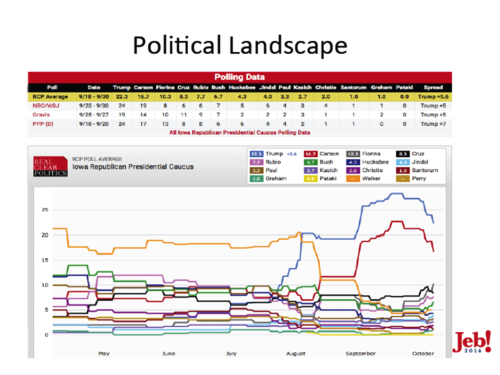Last week, a 112-page slide deck from the Jeb! campaign was leaked to US News. It details the briefing top Bush lieutenants gave to their donors to try and calm the nerves.
It’s a fascinating document, for many of the wrong reasons.
First, when you feel the need to issue a 112 page document about how you’re not in the schtuck, it usually means you’re in the schtuck.
Second, the level of Powerpoint crime is pretty mind-boggling. I’ve written about Powerpoint crime before in academia, and in 2010 the NYT had a great expose of it in the US Army. Sadly, it looks like the Republicans are guilty, too.
There are train schedule slides trying to cram fourteen goals across fifteen time periods into one visual. There’s a pie chart with twelve slices, each labeled in tiny writing, on half a slide. There’s a line chart with ten lines criss-crossing all over the place. There’s a pair of bar charts where nothing is labeled at all, so they could be about anything. And so on. Here’s an example “visual bowl of spaghetti” crime:

The big problem with Powerpoint crime is that it undermines Bush’s message. He wants to appear calm and in “we got this” control, but the visuals evoke a headless chicken clutching at straws.
Third, they’re obviously spinning their friends. That’s a bad sign. Here’s a poll question the Bush team has been asking:
Jeb Bush has proposed a series of reforms to change the political culture in Washington DC, including calling for a Balanced Budget Amendment, term limits and a six year lobbying ban for former lawmakers, and a new law that would cut Congressmen and Senators’ paychecks when they skip votes or hearings.
Most people, unsurprisingly, agree with Bush on this. Who doesn’t like sticking it to absentee politicians and former politicians who play the revolving door?
But Bush’s team tried to tell donors this question was actually about spending restraint (Balanced Budget Amendment) rather than about “culture change in Washington DC” and sticking it to bad lawmakers. They say it shows the public agrees with Bush’s fiscal plans. They’re delusional, and it’s pretty obvious.
Fourth, I was pretty interested in Bush’s analytics platform, despite the fact they called in Ackbar (“It’s a trap!”). They claim to have over 3,000 pieces of information about each of the 260 million people in their database.
That means they’re spending up hugely on consumer data to fine-tune their models. They’ll know not only who voted in which primary in previous elections, but who subscribes to Field & Stream, who has a Twitter account, and who does the grocery shopping in their house. They’ll probably have to estimate who trims downstairs or feeds chickens, but they’ll be pretty good guesses.
But, impressive as that data gathering effort is, the Bush staff are overselling it. On slide 83 (!), they claim:
We know exactly which Republicans are the most likely to turn out and what issues matter to them.
Er, OK. Knowing exactly which people are most likely to do something is an empty claim, because of the uncertainty around “most likely.” If I know exactly that you’re 50% likely to do something, I haven’t the faintest idea what you’re about to do. It’s a known unknown, but its still an unknown.
Also, claiming to know exactly what issues matter to a large group of people just isn’t credible. Ask any statistician. Overselling is another sign of panic. When they make non-credible claims, they undermine their other, more credible ones.
Most of Ackbar’s screenshots are of pretty simplistic data like counts of events by state or polling averages. But they do also show fancy-pants Campaign Simulations. There’s a scatterplot slide with masses of dots, all of which show Jeb winning New Hampshire. Great!
Note of caution, though: They may have stacked the deck, just a little, by only showing the simulations where Bush has a 5+ point lead in the polls on election day. Hmm.
To be fair to Ackbar, the work they’ve done to make their TV advertising 28% more cost effective than buying on ratings alone is pretty impressive, even if it is copied from an Obama technique that was made public a few years ago. They should be well pleased with that.
Overall, though, despite the lead Bush has built in the “invisible primary” for elite endorsements, this slide deck shows a campaign in deep trouble. They’re defensive and casting around for good news, and they’re not in control enough to hide it.
For me, this suggests a subterranean shift in the establishment Republicans away from Bush and towards Rubio, who helped his cause still further in last week’s debate. Assuming the party doesn’t go anti-establishment nuts with someone like Trump, Rubio’s now the favourite.